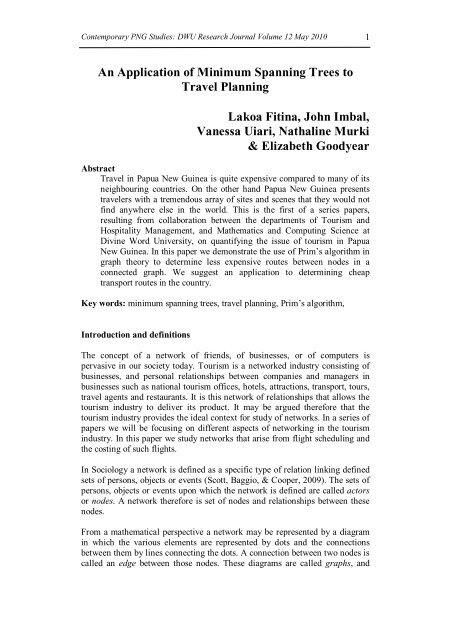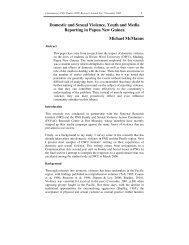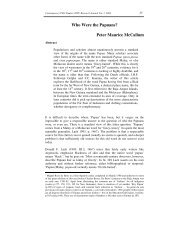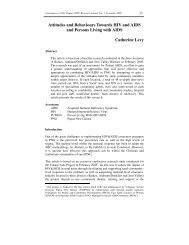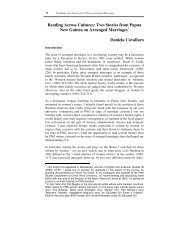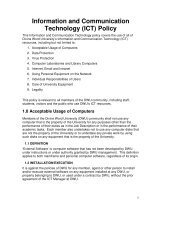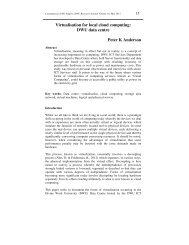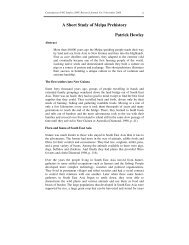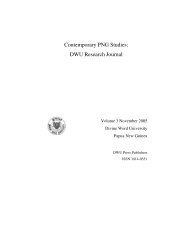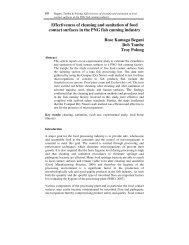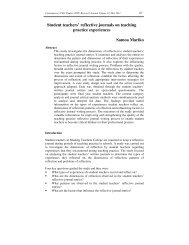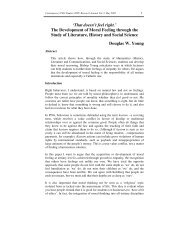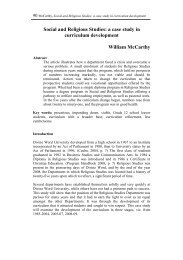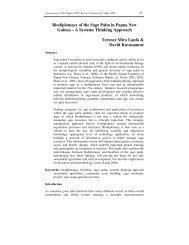An application of minimum spanning trees to travel planning - Informit
An application of minimum spanning trees to travel planning - Informit
An application of minimum spanning trees to travel planning - Informit
You also want an ePaper? Increase the reach of your titles
YUMPU automatically turns print PDFs into web optimized ePapers that Google loves.
Contemporary PNG Studies: DWU Research Journal Volume 12 May 2010 1<br />
<strong>An</strong> Application <strong>of</strong> Minimum Spanning Trees <strong>to</strong><br />
Travel Planning<br />
Lakoa Fitina, John Imbal,<br />
Vanessa Uiari, Nathaline Murki<br />
& Elizabeth Goodyear<br />
Abstract<br />
Travel in Papua New Guinea is quite expensive compared <strong>to</strong> many <strong>of</strong> its<br />
neighbouring countries. On the other hand Papua New Guinea presents<br />
<strong>travel</strong>ers with a tremendous array <strong>of</strong> sites and scenes that they would not<br />
find anywhere else in the world. This is the first <strong>of</strong> a series papers,<br />
resulting from collaboration between the departments <strong>of</strong> Tourism and<br />
Hospitality Management, and Mathematics and Computing Science at<br />
Divine Word University, on quantifying the issue <strong>of</strong> <strong>to</strong>urism in Papua<br />
New Guinea. In this paper we demonstrate the use <strong>of</strong> Prim’s algorithm in<br />
graph theory <strong>to</strong> determine less expensive routes between nodes in a<br />
connected graph. We suggest an <strong>application</strong> <strong>to</strong> determining cheap<br />
transport routes in the country.<br />
Key words: <strong>minimum</strong> <strong>spanning</strong> <strong>trees</strong>, <strong>travel</strong> <strong>planning</strong>, Prim’s algorithm,<br />
Introduction and definitions<br />
The concept <strong>of</strong> a network <strong>of</strong> friends, <strong>of</strong> businesses, or <strong>of</strong> computers is<br />
pervasive in our society <strong>to</strong>day. Tourism is a networked industry consisting <strong>of</strong><br />
businesses, and personal relationships between companies and managers in<br />
businesses such as national <strong>to</strong>urism <strong>of</strong>fices, hotels, attractions, transport, <strong>to</strong>urs,<br />
<strong>travel</strong> agents and restaurants. It is this network <strong>of</strong> relationships that allows the<br />
<strong>to</strong>urism industry <strong>to</strong> deliver its product. It may be argued therefore that the<br />
<strong>to</strong>urism industry provides the ideal context for study <strong>of</strong> networks. In a series <strong>of</strong><br />
papers we will be focusing on different aspects <strong>of</strong> networking in the <strong>to</strong>urism<br />
industry. In this paper we study networks that arise from flight scheduling and<br />
the costing <strong>of</strong> such flights.<br />
In Sociology a network is defined as a specific type <strong>of</strong> relation linking defined<br />
sets <strong>of</strong> persons, objects or events (Scott, Baggio, & Cooper, 2009). The sets <strong>of</strong><br />
persons, objects or events upon which the network is defined are called ac<strong>to</strong>rs<br />
or nodes. A network therefore is set <strong>of</strong> nodes and relationships between these<br />
nodes.<br />
From a mathematical perspective a network may be represented by a diagram<br />
in which the various elements are represented by dots and the connections<br />
between them by lines connecting the dots. A connection between two nodes is<br />
called an edge between those nodes. These diagrams are called graphs, and
2<br />
Fitina et al., <strong>An</strong> <strong>application</strong> <strong>of</strong> <strong>minimum</strong> <strong>spanning</strong> <strong>trees</strong> <strong>to</strong> <strong>travel</strong> <strong>planning</strong><br />
graph theory is the branch <strong>of</strong> mathematics that studies such objects and their<br />
features.<br />
For convenience we will <strong>of</strong>ten denote a graph by letters G or H; the set <strong>of</strong><br />
vertices <strong>of</strong> a graph may be denoted by V or W, and the set <strong>of</strong> edges E or F.<br />
Nodes are denoted by the lowercase letters u, v etc and edges, e, f etc.<br />
Two vertices u and v are said <strong>to</strong> be adjacent or connected if there is an edge<br />
between them. If u and v are nodes then u and v are said <strong>to</strong> be path-connected if<br />
there is a sequence <strong>of</strong> nodes uu 1 u 2 …u n v such that u and u 1 are connected, u 1<br />
and u 2 are connected … , u n and v are connected. The sequence uu 1 u 2 …u n v is<br />
then called a path from u <strong>to</strong> v. A path uu 1 u 2 …u n v is called a cycle if u = v. That<br />
is, uu 1 u 2 …u n u is a cycle.<br />
Figure 1: In the graph below, y and z are path-connected, but y and v are<br />
not path-connected.<br />
A graph in which every pair <strong>of</strong> nodes is path-connected is called a connected<br />
graph. The above graph is not connected. However, the graph below is<br />
connected.<br />
Figure 2: A connected graph<br />
Note that although the above two graphs have the same set <strong>of</strong> nodes, they are<br />
two different graphs.
Contemporary PNG Studies: DWU Research Journal Volume 12 May 2010 3<br />
A graph is said <strong>to</strong> be simple, if there is at most one edge between any two<br />
vertices. That is, any pair <strong>of</strong> vertices is either not connected with an edge, or<br />
there is precisely only one edge between the nodes. The two graphs above,<br />
therefore, are simple. A simple path and simple cycle are similarly defined. A<br />
tree is a connected graph without any cycles. The graph below is a tree.<br />
Figure 3: A tree graph<br />
Given a graph G, if we take out some vertices, or some edges from the graph,<br />
then we end up with what is called a subgraph <strong>of</strong> the graph. Thus, a subgraph<br />
is a graph that is contained in a bigger graph. A subgraph that is also a tree,<br />
such that every node in the bigger graph is also in the subgraph, is called a<br />
<strong>spanning</strong> tree <strong>of</strong> the graph. For example, the graph in Figure 3 is a <strong>spanning</strong><br />
tree <strong>of</strong> the graph in Figure 2. The graph in Figure 1 has no <strong>spanning</strong> tree.<br />
A weighted graph (or tree) is a graph (or tree) in which each edge is assigned a<br />
weight or number. The following graph is a weighted tree. A weighted tree<br />
with <strong>minimum</strong> weight is called a <strong>minimum</strong> <strong>spanning</strong> tree (MST). The weight <strong>of</strong><br />
a graph (or tree) is the sum <strong>of</strong> the weights <strong>of</strong> all the edges in the graph (or tree).<br />
For example, the weight <strong>of</strong> the tree in Figure 4 is 13.<br />
Figure 4: A weighted tree graph
4<br />
Fitina et al., <strong>An</strong> <strong>application</strong> <strong>of</strong> <strong>minimum</strong> <strong>spanning</strong> <strong>trees</strong> <strong>to</strong> <strong>travel</strong> <strong>planning</strong><br />
Travel in Papua New Guinea<br />
Papua New Guinea is a country in the southwestern Pacific Ocean. The<br />
country's geography is diverse and, in places, extremely rugged. A spine <strong>of</strong><br />
mountains runs the length <strong>of</strong> the island <strong>of</strong> New Guinea, forming a populous<br />
highlands region. Dense rainforests can be found in the lowland and coastal<br />
areas. This terrain has made it difficult for the country <strong>to</strong> develop transportation<br />
infrastructure. In some areas, airplanes are the only mode <strong>of</strong> transport<br />
(Wikipedia, http://en.wikipedia.org/wiki/Papua_New_Guinea)<br />
Airlines<br />
Air Niugini is the national airline <strong>of</strong> Papua New Guinea. It operates flights<br />
from the capital city Port Moresby <strong>to</strong> at least 10 overseas destinations. Within<br />
Papua New Guinea it services all the major airports in the country. On any<br />
given day it operates between 50 <strong>to</strong> 70 flights between any two destinations<br />
(nodes). Bookings may be made in one <strong>of</strong> several Air Niugini <strong>of</strong>fices and<br />
agencies around the country and overseas. As well, <strong>travel</strong>ers can make<br />
bookings over the internet at the address http://www.airniugini.com.pg. On this<br />
website there are two interactive maps, a domestic version and an international<br />
version, which convey the same type <strong>of</strong> information.<br />
The domestic interactive map consists <strong>of</strong> the map <strong>of</strong> Papua New Guinea with<br />
the major cities in <strong>to</strong>wns, presumably where the airports are located, depicted<br />
with grey circles. These are the nodes. When a user places the mouse over a<br />
node, red lines appear that lead out from that particular node, <strong>to</strong> other nodes on<br />
the map that have flights <strong>to</strong> and from the chosen node. These red lines are our<br />
edges. The figure below shows what happens on the interactive map when the<br />
mouse points <strong>to</strong> the Port Moresby node.<br />
Figure 5: Domestic airline interactive map <strong>of</strong> Papua New Guinea<br />
Airlines PNG is a private airline that operates flights between Papua New<br />
Guinea and Australia and between numerous destinations within Papua New<br />
Guinea. It also has a website at http://www.apng.com/ where the intending
Contemporary PNG Studies: DWU Research Journal Volume 12 May 2010 5<br />
<strong>travel</strong>er can make bookings. This site includes a route map which is basically a<br />
graph depicting destinations (nodes) and all routes (edges) between the nodes.<br />
In addition <strong>to</strong> the airlines described above, there are several other private and<br />
provincial-owned airlines that operate within certain regions in the country.<br />
Sea <strong>travel</strong><br />
Passenger ships, freighters, charters, outboard dingies and canoes all <strong>of</strong>fer links<br />
between several ports and islands. Perhaps <strong>travel</strong>ing by ship is cheaper,<br />
although sometimes can be uncomfortable. For example, boats <strong>travel</strong> between<br />
Lae and Madang and are run by Lutheran Shipping with facilities including<br />
passenger cabins, accommodation and meals. They also s<strong>to</strong>p in Finschhafen<br />
and Umboi Island.<br />
Several cruise ship companies <strong>of</strong>fer cruises <strong>to</strong> various ports (nodes) in the<br />
country. For example the Aurora <strong>of</strong>fers cruises from Sydney <strong>to</strong> Rabaul and<br />
thence other ports in the country. The Orion Cruise Expeditions <strong>of</strong>fers 5-star<br />
luxury trips <strong>to</strong> the Milne Bay islands, thence <strong>to</strong> the Solomons and other Pacific<br />
destinations.<br />
Travel costs and the weighting <strong>of</strong> a <strong>travel</strong> route<br />
Travel cost is generally expensive; <strong>travel</strong> by boat within the country is<br />
generally cheaper than <strong>travel</strong>ing by air. For <strong>travel</strong>ers on a budget, choosing a<br />
particular route may be important if one is <strong>to</strong> keep within one’s budget. In the<br />
next section we investigate a mathematical method that may be used either<br />
manually, or within a computerized system, that can determine less expensive<br />
routes between any two nodes that are far apart.<br />
According <strong>to</strong> the Independent Consumer and Competition Commission (review<br />
<strong>of</strong> the PNG air transport industry, 2006), the transport cost and the lack <strong>of</strong><br />
transport infrastructure have been identified as major contribu<strong>to</strong>rs <strong>to</strong> the poor<br />
performance <strong>of</strong> the <strong>to</strong>urism industry as a sec<strong>to</strong>r that is particularly reliant on air<br />
transportation. Other fac<strong>to</strong>rs contributing <strong>to</strong> choice <strong>of</strong> air <strong>travel</strong>/transportation<br />
other than fares are, seat comfort, meals provided onboard, staff presentation,<br />
onboard information and entertainment, reliability in performance, journey<br />
time, reputation, passenger benefit programs, disability facilities, free baggage<br />
allowance, coordination, etc. can form part <strong>of</strong> the weighting on a graph (or<br />
tree).<br />
We see therefore that from the mathematical point <strong>of</strong> view the weight <strong>of</strong> an<br />
edge is a fac<strong>to</strong>r <strong>of</strong> fare, comfort, reliability, time <strong>travel</strong>ed, distance <strong>travel</strong>ed,<br />
free baggage allowance, etc. To simplify things we will assume that<br />
w = w( k,<br />
d,<br />
b,<br />
r)<br />
where w, k, d, b and r denote weight, unit fare, distance, free baggage<br />
allowance, and reputation <strong>of</strong> the transport company respectively.
6<br />
Fitina et al., <strong>An</strong> <strong>application</strong> <strong>of</strong> <strong>minimum</strong> <strong>spanning</strong> <strong>trees</strong> <strong>to</strong> <strong>travel</strong> <strong>planning</strong><br />
Suppose that u and v are any two nodes that represent two <strong>travel</strong> destinations<br />
that are connected, or that have an edge between them. Then the weight w <strong>of</strong><br />
the edge uv is a real number that is directly proportional <strong>to</strong> the fare k per unit <strong>of</strong><br />
distance <strong>travel</strong>ed, the distance d <strong>of</strong> <strong>travel</strong>, and is inversely proportional <strong>to</strong> the<br />
reputation r (the reliability index <strong>of</strong>) the transport provider, free baggage<br />
allowance b.<br />
kd<br />
We will define w = c , where c is a constant <strong>of</strong> proportionality. For<br />
br<br />
simplicity, we use c = 1. That is, r is a value between 0 (unreliable) <strong>to</strong> 1<br />
(completely reliable). We note that the actual fare f between the two nodes is f<br />
= kd, so we may rewrite the formula as<br />
f<br />
w = .<br />
br<br />
We point out that since this is (as far as the authors can tell), is the first paper<br />
on the number w, that this is only an approximation at this stage <strong>of</strong> the<br />
research. It may well be that after more research is done this formula may be<br />
extended or improved upon, but for this paper it will be sufficient <strong>to</strong> illustrate<br />
the point about the weighting <strong>of</strong> an edge.<br />
Generally the cost <strong>of</strong> <strong>travel</strong> is fixed between any two nodes. In some rare cases<br />
one may negotiate the fare. This is especially true if the transport provider is a<br />
small opera<strong>to</strong>r running a boat between islands, or a small taxi business still<br />
trying <strong>to</strong> expand its cus<strong>to</strong>mer base.<br />
In this study we assume that the cost f is fixed. The number r is a measure <strong>of</strong><br />
how reliable an opera<strong>to</strong>r is. For specific opera<strong>to</strong>rs some time may be needed <strong>to</strong><br />
determine the limits <strong>of</strong> this number. In this paper we will assume r <strong>to</strong> be a<br />
function<br />
r<br />
: Ω → [0,1]<br />
from the set Ω <strong>of</strong> transport providers <strong>to</strong> the closed interval from 0 <strong>to</strong><br />
1.Therefore r is a fuzzy indica<strong>to</strong>r. We will investigate this function more<br />
carefully in a later paper.<br />
The number b is the number <strong>of</strong> kilos <strong>of</strong> baggage one is allowed free, after<br />
which the passenger is then asked <strong>to</strong> pay ‘excess baggage’ fare. For most<br />
transport opera<strong>to</strong>rs this is a fixed integer.<br />
In the case <strong>of</strong> <strong>travel</strong> via an Air Niugini flight, the number b is 16 (kg). The<br />
current fare between Port Moresby and Madang is 566.70 (K). For argument’s
Contemporary PNG Studies: DWU Research Journal Volume 12 May 2010 7<br />
sake suppose we assume that r = 0.8. Then the weight along the Madang Port<br />
Moresby route is<br />
566.70<br />
w = = 44. 3<br />
16×<br />
0.8<br />
We will study the number w in more detail in a subsequent paper. For now we<br />
will demonstrate the use <strong>of</strong> Prim’s algorithm <strong>to</strong> determining the route <strong>of</strong> least<br />
costing between any two nodes in within a <strong>travel</strong> plan. In this case c = b = r =<br />
1, so w is equal <strong>to</strong> the cost, f.<br />
Prim’s <strong>minimum</strong> <strong>spanning</strong> tree algorithm<br />
Given a graph, one is <strong>of</strong>ten interested in determining a <strong>minimum</strong> <strong>spanning</strong> tree<br />
from the theoretical point <strong>of</strong> view. In this paper our interest in <strong>minimum</strong><br />
<strong>spanning</strong> <strong>trees</strong> arises from our interest in applying <strong>minimum</strong> <strong>spanning</strong> tree<br />
algorithms <strong>to</strong> determining low cost and perhaps most efficient and therefore<br />
satisfying route between all the nodes one hopes <strong>to</strong> visit. In particular, we will<br />
apply the Prim’s algorithm.<br />
Prim’s algorithm is an algorithm in graph theory that determines a <strong>minimum</strong><br />
<strong>spanning</strong> tree for a connected weighted graph. This algorithm determines a<br />
sub-graph <strong>of</strong> the weighted graph, which is a weighted tree that contains all <strong>of</strong><br />
the nodes from the original graph.<br />
Prim's algorithm has the property that the edges in the set A always form a<br />
single tree. We begin with some vertex v in a given graph G with sets <strong>of</strong><br />
vertices V and set <strong>of</strong> edges E, defining the initial set <strong>of</strong> vertices A. Then, in<br />
each iteration, we choose a <strong>minimum</strong>-weight edge (u, v), connecting a vertex v<br />
in the set A <strong>to</strong> the vertex u outside <strong>of</strong> set A. Then vertex u is brought in <strong>to</strong> A.<br />
This process is repeated until a <strong>spanning</strong> tree is formed. We always choose the<br />
smallest-weight edge joining a vertex inside set A <strong>to</strong> the one outside the set A.<br />
The implication <strong>of</strong> this fact is that it adds only edges that are “safe” for A; that<br />
is, when the algorithm terminates, the edges in set A form a MST.<br />
Figure 6: Prim’s Algorithm<br />
We describe this algorithm in pseudo-code form as follows:<br />
let A be a single vertex u<br />
while (A has fewer than n vertices)<br />
{<br />
}<br />
find the smallest edge connecting A <strong>to</strong> G − A<br />
add it <strong>to</strong> A
8<br />
Fitina et al., <strong>An</strong> <strong>application</strong> <strong>of</strong> <strong>minimum</strong> <strong>spanning</strong> <strong>trees</strong> <strong>to</strong> <strong>travel</strong> <strong>planning</strong><br />
To illustrate this algorithm, consider the different ways <strong>of</strong> <strong>travel</strong>ing from<br />
Rabaul (RAB) <strong>to</strong> Manus (MAS) in a route that includes s<strong>to</strong>ps at each <strong>of</strong> the<br />
other locations. The following graph contains routes <strong>to</strong> and from Rabaul and<br />
Manus. For simplicity we exclude the routes <strong>to</strong> and from Lihir.<br />
Figure 7: Graph contains routes <strong>to</strong> and from Rabaul and Manus<br />
Here, the nodes are different <strong>to</strong>wns or airports: In particular RAB stands for the<br />
<strong>to</strong>wn Rabaul, and MAS for Manus, etc. The weights <strong>of</strong> the edges in the graph<br />
are the costs <strong>of</strong> the fares between the different nodes. To start, we pick the node<br />
RAB. This node forms the start <strong>of</strong> our <strong>spanning</strong> tree A. We look at all the edges<br />
going out from RAB, and choose an edge <strong>of</strong> <strong>minimum</strong> weight that joins RAB<br />
<strong>to</strong> a node outside <strong>of</strong> the tree A. In this case, we choose the edge with weight<br />
415, that connects RAB <strong>to</strong> HKN. The tree A now contains the nodes RAB,<br />
HKN and the edge with weight 415 between these two nodes. We now look<br />
outside <strong>of</strong> A for a node that is joined minimally <strong>to</strong> a node in A. Such a node is<br />
KAV, which is joined by an edge with weight 420, <strong>to</strong> KAV. If we continue, we<br />
get this sequence <strong>of</strong> <strong>trees</strong>:
Contemporary PNG Studies: DWU Research Journal Volume 12 May 2010 9<br />
Fig 8-a: A with two nodes<br />
Fig 8-b: A with three nodes<br />
Fig 8-c: A with four nodes<br />
Fig 8-d: A with five nodes<br />
Fig 8-e: A with six nodes<br />
Fig 8-f: A with 7 nodes
10<br />
Fitina et al., <strong>An</strong> <strong>application</strong> <strong>of</strong> <strong>minimum</strong> <strong>spanning</strong> <strong>trees</strong> <strong>to</strong> <strong>travel</strong> <strong>planning</strong><br />
Fig 8-g: A with 8 nodes<br />
Fig 8-g represents the <strong>minimum</strong> <strong>spanning</strong> tree <strong>of</strong> the connected graph in Figure<br />
7. This is the subtree with <strong>minimum</strong> weight. What this means is that if one<br />
wants <strong>to</strong> visit all the nodes in Figure 7, this is the route that one should take in<br />
order <strong>to</strong> minimize cost. In this case, the <strong>to</strong>tal cost is K3350.<br />
This is not as simple as it looks. In order <strong>to</strong> take full advantage <strong>of</strong> this tree, one<br />
has <strong>to</strong> visit at least one <strong>of</strong> the nodes more than once. For example a possible<br />
route is MAD, POM, LAE, HKN, RAB, BUA, RAB, KAV, MAS. Here, a<br />
person starts at MAD, then POM, etc until he/she reaches RAB. From RAB<br />
he/she takes the trip <strong>to</strong> BUA, then back again <strong>to</strong> RAB and thence <strong>to</strong> HKN,<br />
KAV and MAS. Thus RAB is visited twice.<br />
However, even with the above scenario, one still spends less than any other<br />
route in the graph, in which every node is visited at least once (as one can<br />
easily verify).<br />
We have deliberately simplified the problem <strong>of</strong> choosing a route by1) taking a<br />
small number <strong>of</strong> nodes, 2) by taking only edges serviced by airplanes, 3)<br />
ignoring reliability, seat comfort, etc 4) by excluding one or two routes. The<br />
situation will drastically increase in complexity when boat trips, buses, etc are<br />
fac<strong>to</strong>red in, including the fares for these transport modes, even for a small<br />
number <strong>of</strong> nodes.<br />
Conclusion<br />
In this paper we demonstrated the use <strong>of</strong> Prim’s algorithm <strong>to</strong> obtain a <strong>minimum</strong><br />
<strong>spanning</strong> tree from a given connected graph. When the nodes <strong>of</strong> the graph<br />
represent transportation nodes then a <strong>minimum</strong> <strong>spanning</strong> tree can suggest a<br />
route <strong>of</strong> lowest cost or close <strong>to</strong> lowest cost through all the nodes in the graph.<br />
This may be extremely useful when designing a <strong>to</strong>ur consisting <strong>of</strong> different<br />
destinations and sites in the country.
Contemporary PNG Studies: DWU Research Journal Volume 12 May 2010 11<br />
The algorithm can reduce the amount <strong>of</strong> time needed <strong>to</strong> determine a route, and<br />
as well, increase the <strong>travel</strong>ler’s confidence in the suggested route. The situation<br />
can become extremely complex when different types <strong>of</strong> transportation are<br />
included, as well as the different variables discussed in the previous section.<br />
But that will be the focus <strong>of</strong> a subsequent paper.<br />
References<br />
Airlines PNG website, http://www.apng.com/<br />
AirNiugini website , http://www.airniugini.com.pg<br />
Independent Consumer and Competition Commission (Review <strong>of</strong> the PNG Air<br />
Transport Industry, Final Report, 20 th September 2006),<br />
Scott, Noel; Baggio, Rodolfo & Cooper, Chris 2009, Network <strong>An</strong>alysis and<br />
Tourism: From Theory <strong>to</strong> Practice, Channel View Publications, NY.<br />
Traveler’s Point, http://www.<strong>travel</strong>lerspoint.com/guide/Papua_New_Guinea/<br />
Wikipedia, http://en.wikipedia.org/wiki/Papua_New_Guinea<br />
Authors<br />
Dr Lakoa Fitina is the Head <strong>of</strong> the Mathematics and Computing Department<br />
and Mr John Imbal Fitina is the Head <strong>of</strong> the Tourism and Hospitality<br />
Management Department at Divine Word University. Ms Vanessa Uiari, Ms<br />
Nathaline Murki and Ms Elizabeth Goodyear are lecturers within the Tourism<br />
and Hospitality Management Department. The departments are part <strong>of</strong> the<br />
Faculty <strong>of</strong> Business and Informatics at Divine Word University.


